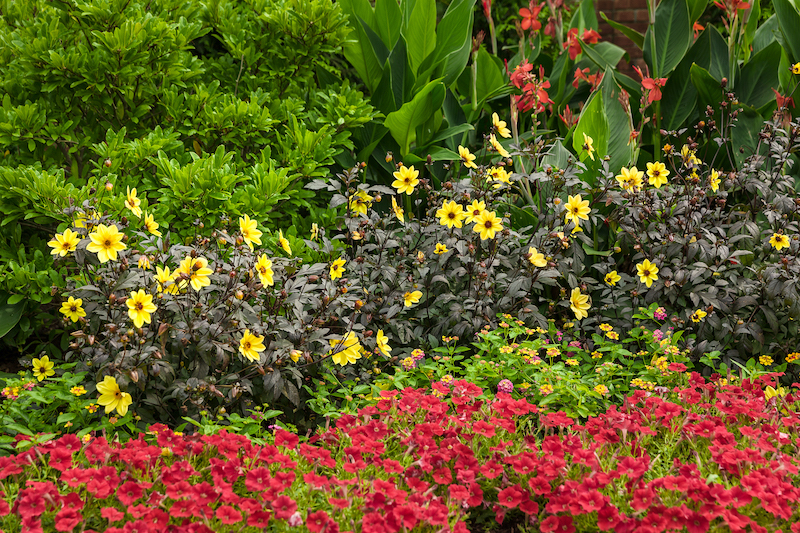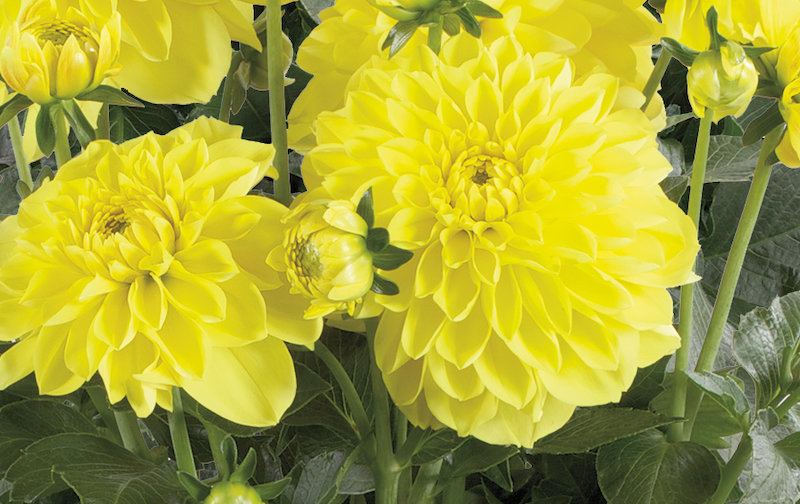Dahlias are a showstopping addition to any landscape. With a wide array of colors and flower sizes, your garden will be full of beauty from midsummer to fall. Dahlias are also a symbol of kindness, commitment, and steadfastness as they continue to bloom after other summer flowers have stopped. A member of the Asteraceae family, there are 30+ dahlia species and thousands of cultivars to choose from! Dahlias can sometimes be challenging to grow, but with these tips, you should have a successful and beautiful crop.

What You Need To Plant Dahlias
- Compost or manure
- Garden spade
- Fertilizer
- Water source
Where to Plant Dahlias
Dahlias need 6-8 hours of direct sunlight per day. They prefer well-draining soil with a pH of 6-7.5. Adding compost is a great way to ensure your soil drains properly, as well as adding nutrients. Most Dahlias are grown from tubers and more prone to rot for this reason. Ensuring your soil drains properly will keep these flowers happy and healthy. If you wish to plant Dahlias in the ground, dig a hole a few inches deeper than the nursery pot they came to you in. Dahlias can grow very tall and be top heavy so you need to counteract this. If you would like to grow Dahlias in containers the same principle applies. Make sure your container is large enough for plenty of substrate to support this plant, at least 3 gallons.

Dahlia Spacing
When planting Dahlias, spacing and quantity really depends on what you wish to achieve in your landscape design! Through proper pruning, some varieties will become bushier and flower more. However some varieties are less bushy and require staking. Dahlias will not creep or spread. If you wish to harvest these flowers, spacing is very important. Smaller varieties can be planted 9-12 inches apart. Medium-height varieties should be planted 2 feet apart, as some may need to be staked when they flower and will appreciate adequate air circulation. Tall varieties should be planted 3 feet apart as they will need to be staked. All varieties can be planted closer together to create a natural drift appearance.
Steps To Plant Dahlias
Step 1 - Choose a space with plenty of direct sunlight, at least 6 hours per day. Intense afternoon sun can bleach the leaves and flowers, so consider an eastern exposure if you live in a hot climate.
Step 2 - Amend soil with compost or manure to help with drainage if needed. Remember, Dahlias roots/tubers are sensitive to moisture.
Step 3 - Dahlias do best with a low-nitrogen fertilizer, approximating 5-10-10 fertilizer. Generally fertilize once a month after sprouting, as they are sensitive to over-fertilizing.
Step 4 - Dig a hole a few inches deeper than your nursery pot. Cover with 1-3 inches of soil. Topdress the root zone with compost.
Step 5 - Water 2-3 times a week during the summer depending on your climate. If you are planting a Dahlia in a container rather than the ground, you will need to water and fertilize more frequently because potting soil doesn’t retain water or nutrients like soil in the ground. You may notice your plants in pots dry out quickly in the heat of the summer and will need to increase watering as necessary.
When to Plant Dahlias
Dahlias are native to Mexico and prefer warm climates. They can be planted in many different hardiness zones but are considered annuals in any zone below 8. You should plant them after the risk of frost is gone. A good rule of thumb is when it’s time to plant tomatoes in your zone, you can plant Dahlias! For example, if you live in zone 6, typically June is a good time to plant tomatoes and therefore Dahlias.

Transplanting Dahlias
Dahlias are actually an excellent plant to divide so you may spread them around your garden next year! In warm climates, they are considered perennials, and with proper care and effort, you can expand your clumps year after year. If you wish to save your Dahlias to replant the following year, you can cut them back as temperatures start dropping. Carefully dig up the root balls and clean all soil off. Separate the tuber clusters. Let them dry, and store them in a cool and dark place surrounded by vermiculite or peat moss.
 |
Author Chris Link - Published 01-24-2023 |
